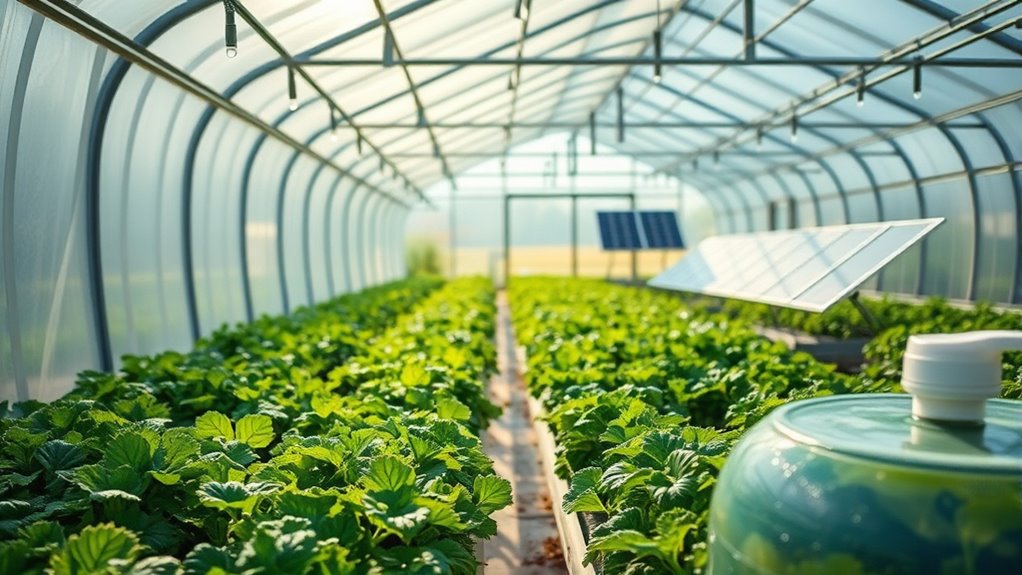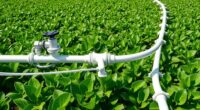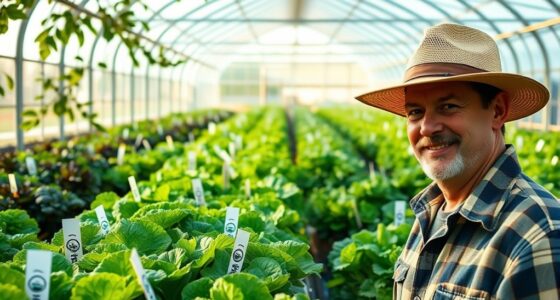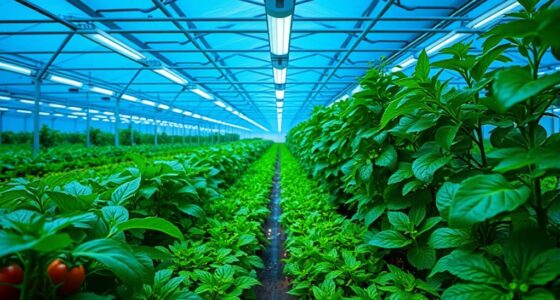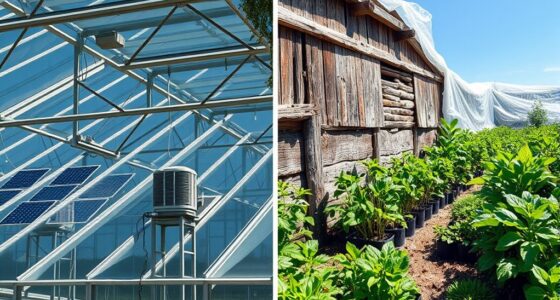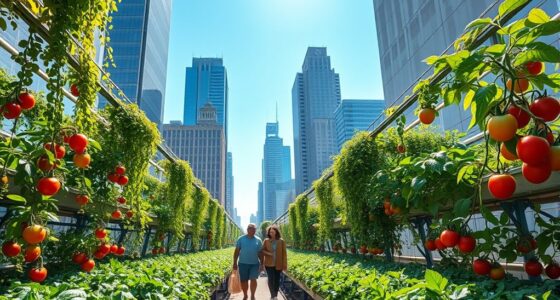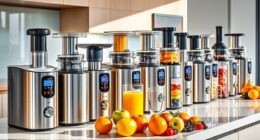To make your greenhouse farming more sustainable, focus on water-saving techniques like installing drip irrigation that delivers water directly to plant roots, and use moisture sensors to prevent overwatering. Harvest rainwater to reduce dependence on municipal sources and lower your water bills. Regularly inspect and maintain your watering systems to guarantee efficiency. Combining these practices can considerably conserve water and promote eco-friendly farming—keep going to discover even more effective strategies.
Key Takeaways
- Implement drip irrigation systems to deliver targeted water directly to plant roots, reducing evaporation and runoff.
- Use rainwater harvesting to collect and store rainwater, decreasing dependence on municipal water sources.
- Deploy moisture sensors to monitor soil moisture levels and optimize watering schedules, avoiding over or underwatering.
- Regularly inspect and maintain irrigation and rainwater systems to ensure efficient operation and prevent water wastage.
- Combine sustainable practices like drip irrigation, rainwater harvesting, and sensor use to maximize water efficiency and environmental benefits.
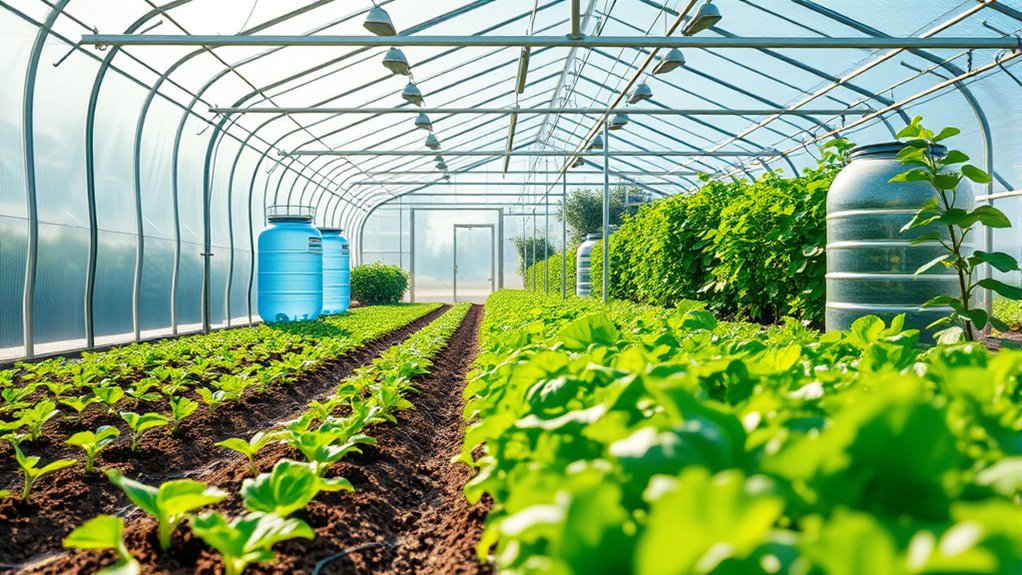
Greenhouse farming can be highly productive, but conserving water is essential for sustainability. You want to ensure your operation remains efficient and environmentally friendly, which means adopting smart water-saving techniques. One of the most effective ways to do this is by installing drip irrigation systems. Unlike traditional sprinklers that spray water over broad areas, drip irrigation delivers water directly to the roots of your plants through a network of tubes and emitters. This targeted approach minimizes evaporation and runoff, ensuring each drop counts. It also helps you maintain consistent soil moisture levels, promoting healthier plant growth and reducing water waste. Plus, drip irrigation systems are relatively easy to set up and automate, so you can manage watering schedules with minimal effort.
Another critical practice is rainwater harvesting. By capturing and storing rainwater, you reduce your reliance on municipal water sources and make your greenhouse more self-sufficient. You can set up simple collection systems using gutters and storage tanks positioned to gather rainwater from your greenhouse roof. This stored water can then be used during dry periods, ensuring your plants receive a steady supply without extra cost or resource consumption. Rainwater harvesting not only cuts down your water bills but also helps mitigate the environmental impact of overusing freshwater resources. It’s a sustainable cycle that benefits your operation and the planet.
In addition to these methods, consider integrating moisture sensors into your greenhouse. These devices provide real-time data on soil moisture levels, allowing you to water only when necessary. When combined with drip irrigation, moisture sensors ensure you’re not overwatering or underwatering, further conserving water and promoting healthy plant growth. Implementing a watering schedule based on sensor data helps you avoid waste and optimize resource use.
Furthermore, you should regularly inspect and maintain your irrigation systems. Clogged emitters or leaks can cause uneven watering and waste water unnecessarily. Routine checks ensure your drip lines are functioning correctly and that rainwater harvesting systems are clean and operational. Small maintenance efforts can considerably improve water efficiency in the long run.
Frequently Asked Questions
How Does Climate Change Impact Water Conservation in Greenhouse Farming?
Climate change increases water demand and challenges your ability to conserve water in greenhouse farming. You must adapt your climate strategies to guarantee efficient water use, as rising temperatures and shifting weather patterns create unpredictable water availability. By implementing climate adaptation measures, you can better manage water resources, reduce waste, and maintain sustainable practices despite the growing pressures of climate change on water conservation efforts.
What Are the Costs Associated With Implementing Water-Saving Technologies?
Implementing water-saving technologies costs you an initial investment, which varies depending on the system’s complexity and size. You’ll also face ongoing maintenance costs to guarantee efficient operation and longevity. While these expenses might seem high upfront, they often lead to significant savings over time by reducing water consumption and lowering utility bills. Overall, careful planning helps you balance initial costs with long-term sustainability benefits.
Can Water Recycling Methods Be Integrated Into Existing Greenhouse Setups?
You can definitely integrate water recycling methods into your greenhouse setup. Start with rainwater harvesting systems to collect and store rainwater efficiently. Then, use drip irrigation to minimize water waste and deliver water directly to plants’ roots. These methods are adaptable to existing greenhouses, helping you save water and reduce costs. Incorporating rainwater harvesting and drip irrigation makes your greenhouse more sustainable without extensive overhaul.
How Do Water-Saving Practices Vary for Different Crops?
They say, “Different strokes for different folks,” and that’s true for crop-specific irrigation. You need to grasp water requirement variation among crops to optimize water-saving practices. For example, leafy greens might need frequent, light watering, while root vegetables require deeper, less frequent watering. Adjust your irrigation techniques based on these needs to reduce waste, conserve water, and ensure healthy, sustainable growth for each crop.
What Are the Long-Term Benefits of Water Conservation for Greenhouse Sustainability?
Focusing on water conservation benefits your greenhouse’s long-term sustainability. You improve water efficiency and strengthen resource management, reducing waste and lowering costs. This approach guarantees a reliable water supply during dry periods and minimizes environmental impact. Over time, you’ll see healthier crops, better yields, and increased resilience against climate variability. Prioritizing water conservation helps you build a sustainable greenhouse operation that’s economically and environmentally responsible, ensuring success for years to come.
Conclusion
By adopting these water-saving tips, you’ll transform your greenhouse into a model of sustainability. Every drop you conserve not only supports healthier plants but also saves enough water to fill an entire swimming pool—imagine that! Your commitment can make a huge difference, proving that small changes lead to massive environmental impacts. Stay proactive, keep learning, and watch your greenhouse flourish while saving the planet—because, truly, every drop counts more than you realize.
